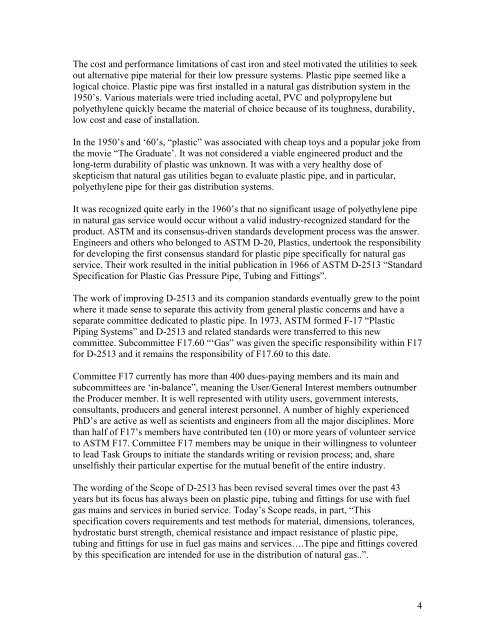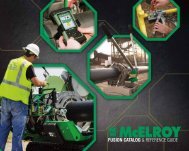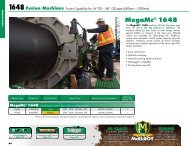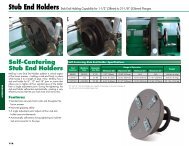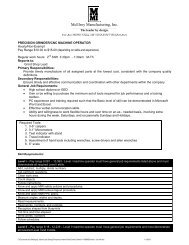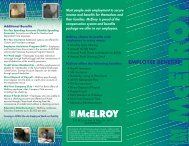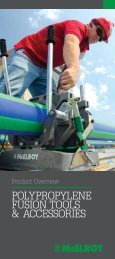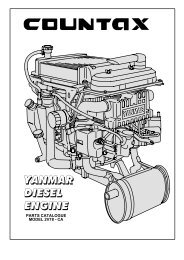THE TEN BILLION DOLLAR STANDARD ASTM D-2513 By: John ...
THE TEN BILLION DOLLAR STANDARD ASTM D-2513 By: John ...
THE TEN BILLION DOLLAR STANDARD ASTM D-2513 By: John ...
Create successful ePaper yourself
Turn your PDF publications into a flip-book with our unique Google optimized e-Paper software.
The cost and performance limitations of cast iron and steel motivated the utilities to seekout alternative pipe material for their low pressure systems. Plastic pipe seemed like alogical choice. Plastic pipe was first installed in a natural gas distribution system in the1950’s. Various materials were tried including acetal, PVC and polypropylene butpolyethylene quickly became the material of choice because of its toughness, durability,low cost and ease of installation.In the 1950’s and ‘60’s, “plastic” was associated with cheap toys and a popular joke fromthe movie “The Graduate’. It was not considered a viable engineered product and thelong-term durability of plastic was unknown. It was with a very healthy dose ofskepticism that natural gas utilities began to evaluate plastic pipe, and in particular,polyethylene pipe for their gas distribution systems.It was recognized quite early in the 1960’s that no significant usage of polyethylene pipein natural gas service would occur without a valid industry-recognized standard for theproduct. <strong>ASTM</strong> and its consensus-driven standards development process was the answer.Engineers and others who belonged to <strong>ASTM</strong> D-20, Plastics, undertook the responsibilityfor developing the first consensus standard for plastic pipe specifically for natural gasservice. Their work resulted in the initial publication in 1966 of <strong>ASTM</strong> D-<strong>2513</strong> “StandardSpecification for Plastic Gas Pressure Pipe, Tubing and Fittings”.The work of improving D-<strong>2513</strong> and its companion standards eventually grew to the pointwhere it made sense to separate this activity from general plastic concerns and have aseparate committee dedicated to plastic pipe. In 1973, <strong>ASTM</strong> formed F-17 “PlasticPiping Systems” and D-<strong>2513</strong> and related standards were transferred to this newcommittee. Subcommittee F17.60 “‘Gas” was given the specific responsibility within F17for D-<strong>2513</strong> and it remains the responsibility of F17.60 to this date.Committee F17 currently has more than 400 dues-paying members and its main andsubcommittees are ‘in-balance”, meaning the User/General Interest members outnumberthe Producer member. It is well represented with utility users, government interests,consultants, producers and general interest personnel. A number of highly experiencedPhD’s are active as well as scientists and engineers from all the major disciplines. Morethan half of F17’s members have contributed ten (10) or more years of volunteer serviceto <strong>ASTM</strong> F17. Committee F17 members may be unique in their willingness to volunteerto lead Task Groups to initiate the standards writing or revision process; and, shareunselfishly their particular expertise for the mutual benefit of the entire industry.The wording of the Scope of D-<strong>2513</strong> has been revised several times over the past 43years but its focus has always been on plastic pipe, tubing and fittings for use with fuelgas mains and services in buried service. Today’s Scope reads, in part, “Thisspecification covers requirements and test methods for material, dimensions, tolerances,hydrostatic burst strength, chemical resistance and impact resistance of plastic pipe,tubing and fittings for use in fuel gas mains and services….The pipe and fittings coveredby this specification are intended for use in the distribution of natural gas..”.4


